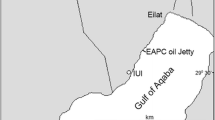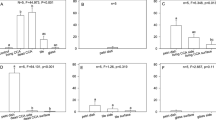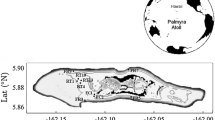Abstract
Oxygen is a critical resource that mediates a multitude of essential processes and interactions at multiple scales on coral reefs. In adult corals, it can directly or indirectly impact physiological processes, such as photosynthesis, respiration, and calcification. Moreover, many corals bleach as a consequence of being exposed to low oxygen. The sessile adult phase of corals makes habitat selection crucial for post-settlement survival and thus their pelagic larvae use a diverse array of cues to determine a suitable spot for settlement. However, the effects of oxygen on the early life stages of corals are still poorly known. This study investigated the importance of oxygen as a potential settlement cue and its effect on swimming and settlement behavior of coral larvae of two Acropora species. Two experiments were performed, one investigating coral larval swimming behavior under different oxygen conditions and the other studying coral larval settlement along an oxygen gradient. Bottom exploration, expressed as the percent of A. cytherea and A. pulchra larvae in the bottom section of experimental cylinders, was reduced by 96% and 100%, respectively, in hypoxic water compared to normoxic water. When offered the choice to settle on an otherwise preferred settlement substrate (Titanoderma prototypum) along an oxygen gradient, larvae of both coral species settled almost exclusively on T. prototypum fragments placed in well-oxygenated environments, with settlement rates increasing nonlinearly with oxygen concentrations. These results suggest that low-oxygen areas can negatively influence the settlement success of coral larvae and that oxygen concentration may be used as a cue for coral larval swimming and settlement behavior.


Similar content being viewed by others
References
Adjeroud M, Andréfouët S, Payri C (2001) Mass mortality of macrobenthic communities in the lagoon of Hikueru atoll (French Polynesia). Coral Reefs 19:287–291
Albert S, Dunbabin M, Skinner M, Moore B, Grinham A (2012) Benthic shift in a Solomon Islands’ lagoon: corals to cyanobacteria. In: Proceedings of the 12th International Coral Reef Symposium, Cairns, Australia
Albright R (2011) Reviewing the effects of ocean acidification on sexual reproduction and early life history stages of reef-building corals. J Mar Biol 2011:1–14
Albright R, Mason B, Langdon C (2008) Effect of aragonite saturation state on settlement and post-settlement growth of Porites astreoides larvae. Coral Reefs 27:485–490
Altieri AH, Gedan KB (2015) Climate change and dead zones. Glob Chang Biol 21:1395–1406
Altieri AH, Harrison SB, Seemann J, Collin R, Diaz RJ, Knowlton N (2017) Tropical dead zones and mass mortalities on coral reefs. Proc Natl Acad Sci USA 114:3660–3665
Anderson MJ (1996) A chemical cue induces settlement of Sydney rock oysters, Saccostrea commercialis, in the laboratory and in the field. Biol Bull 190:350–358
Anderson MJ, Underwood AJ (1994) Effects of substratum on the recruitment and development of an intertidal estuarine fouling assemblage. J Exp Mar Biol 184:217–236
Andréfouët S, Dutheil C, Menkes CE, Bador M, Lengaigne M (2015) Mass mortality events in atoll lagoons: environmental control and increased future vulnerability. Glob Chang Biol 21:195–205
Babcock R, Mundy C (1996) Coral recruitment: Consequences of settlement choice for early growth and survivorship in two scleractinians. J Exp Mar Bio Ecol 206:179–201
Baker SM, Mann R (1992) Effects of hypoxia and anoxia on larval settlement, juvenile growth, and juvenile survival of the oyster Crassostrea virginica. Biol Bull 182:265–269
Barott KL, Rohwer FL (2012) Unseen players shape benthic competition on coral reefs. Trends Microbiol 20:621–628
Barott KL, Rodriguez-Mueller B, Youle M, Marhaver KL, Vermeij MJ, Smith JE, Rohwer FL (2012) Microbial to reef scale interactions between the reef-building coral Montastraea annularis and benthic algae. Proc R Soc B 22:1655–1664
Bates D, Mächler M, Bolker B, Walker S (2015) Fitting linear mixed-effects models using lme4. J Stat Softw 67:1–48
Birrell CL, McCook LJ, Willis BL, Harrington L (2008) Chemical effects of macroalgae on larval settlement of the broadcast spawning coral Acropora millepora. Mar Ecol Prog Ser 362:129–137
Bodamer BL, Bridgeman TB (2014) Experimental dead zones: two designs for creating oxygen gradients in aquatic ecological studies. Limnol Oceanogr Methods 12:441–454
Bruno JF, Selig ER, Casey KS, Page CA, Willis BL, Harvell CD, Sweatman H, Melendy AM (2007) Thermal stress and coral cover as drivers of coral disease outbreaks. PLoS Biol 5:e124
Byrne M (2011) Impact of ocean warming and ocean acidification on marine invertebrate life history stages: vulnerabilities and potential for persistence in a changing ocean. Oceanography and Marine Biology Annual Reviews 49:1–42
Campanati C, Yip S, Lane A, Thiyagarajan V (2016) Combined effects of low pH and low oxygen on the early-life stages of the barnacle Balanus amphitrite. ICES J Mar Sci 73:791–802
Colombo-Pallotta MF, Rodríguez-Román A, Iglesias-Prieto R (2010) Calcification in bleached and unbleached Montastraea faveolata: evaluating the role of oxygen and glycerol. Coral Reefs 29:899–907
Coon SL, Walch M, Fitt WK, Weiner RM, Bonar DB (1990) Ammonia induces settlement behavior in oyster larvae. Biol Bull 179:297–303
Côte M, Knowlton N (2013) Coral reef ecosystems: a decade of discoveries. In: Bertness MD, Bruno JF, Silliman BR, Stachowicz JJ (eds) Marine community ecology and conservation. Sinauer Associates, Sunderland, pp 299–314
Da-Anoy JP, Villanueva RD, Cabaitan PC, Conaco C (2017) Effects of coral extracts on survivorship, swimming behavior, and settlement of Pocillopora damicornis larvae. J Exp Mar Bio Ecol 486:93–97
Diaz RJ (2001) Overview of hypoxia around the world. J Environ Qual 30:275–281
Diaz RJ, Rosenberg R (1995) Marine benthic hypoxia: a review of its ecological effects and the behavioural responses of benthic macrofauna. Oceanogr Mar Biol 33:245–303
Diaz RJ, Breitburg DL (2009) The hypoxic environment. In: Richards JG, Farrell AP, Brauner CJ (eds) Fish physiology. Academic Press, New York, pp 1–23
Doropoulos C, Ward S, Diaz-Pulido G, Hoegh-Guldberg O, Mumby PJ (2012) Ocean acidification reduces coral recruitment by disrupting intimate larval-algal settlement interactions. Ecol Lett 15:338–346
Dumas P, Tiavouane J, Senia J, Willam A, Dick L, Fauvelot C (2014) Evidence of early chemotaxis contributing to active habitat selection by the sessile giant clam Tridacna maxima. J Exp Mar Bio Ecol 452:63–69
Edmunds PJ, Leichter JJ, Adjeroud M (2010) Landscape-scale variation in coral recruitment in Moorea, French Polynesia. Mar Ecol Prog Ser 13:75–89
Edmunds PJ, Cumbo VR, Fan TY (2013) Metabolic costs of larval settlement and metamorphosis in the coral Seriatopora caliendrum under ambient and elevated pCO2. J Exp Mar Bio Ecol 443:33–38
Elmer F, Bell JJ, Gardner JPA (2018) Coral larvae change their settlement preference for crustose coralline algae dependent on availability of bare space. Coral Reefs 37:397–407
Fabricius KE, Noonan SH, Abrego D, Harrington L, De’Ath G (2017) Low recruitment due to altered settlement substrata as primary constraint for coral communities under ocean acidification. Proc Royal Soc B 284:20171536
Ferguson N, White CR, Marshall DJ (2013) Competition in benthic marine invertebrates: the unrecognized role of exploitative competition for oxygen. Ecology 94:126–135
Finelli CM, Helmuth BST, Pentcheff ND, Wethey DS (2006) Water flow influences oxygen transport and photosynthetic efficiency in corals. Coral Reefs 25:47–57
Forward RB, Tankersley RA, Rittschof D (2001) Cues for metamorphosis of Brachyuran crabs: an overview. Am Zool 41:1108–1122
Foster T, Gilmour JP, Chua CM, Falter JL, McCulloch MT (2015) Effect of ocean warming and acidification on the early life stages of subtropical Acropora spicifera. Coral Reefs 34:217–1226
Gardella DJ, Edmunds PJ (1999) The oxygen microenvironment adjacent to the tissue of the scleractinian Dichocoenia stokesii and its effects on symbiont metabolism. Mar Biol 135:289–295
Gleason DF, Edmunds PJ, Gates RD (2006) Ultraviolet radiation effects on the behavior and recruitment of larvae from the reef coral Porites astreoides. Mar Biol 148:503–512
Gleason DF, Danilowicz BS, Nolan CJ (2009) Reef waters stimulate substratum exploration in planulae from brooding Caribbean corals. Coral Reefs 28:549–554
Graham EM, Baird AH, Connolly SR (2008) Survival dynamics of scleractinian coral larvae and implications for dispersal. Coral Reefs 27:529–539
Gregg A, Hatay M, Haas A, Robinett N, Barott K, Vermeij M, Marhaver K, Meirelles P, Thompson F, Rohwer F (2013) Biological oxygen demand optode analysis of coral reef-associated microbial communities exposed to algal exudates. PeerJ 1:e107
Guzmán H, Cortés J, Glynn P, Richmond R (1990) Coral mortality associated with dino-flagellate blooms in the eastern Pacific (Costa Rica and Panama). Mar Ecol Prog Ser 60:299–303
Haas AF, Gregg AK, Smith JE, Abieri ML, Hatay M, Rohwer F (2013) Visualization of oxygen distribution patterns caused by coral and algae. PeerJ 1:e106
Hadfield M, Paul V (2001) Natural chemical cues for settlement and metamorphosis of marine-invertebrate larvae. In: McClinTock J, Baker B (eds) Marine chemical ecology. CRC Press, Cambridge, pp 431–461
Harrington L, Fabricius K, De’ath G, Negri A (2004) Recognition and selection of settlement substrate determine post-settlement survival in corals. Ecology 85:3428–3437
Hata T, Madin JS, Cumbo VR, Denny M, Figueiredo J, Harii S, Thomas CJ, Baird AH (2017) Coral larvae are poor swimmers and require fine-scale reef structure to settle. Sci Rep 7:2249
Hillesdon AJ, Pedley TJ (1996) Bioconvection in suspensions of oxytactic bacteria: linear theory. J Fluid Mech 324:223–259
Heyward AJ, Negri AP (1999) Natural inducers of coral larval metamorphosis. Coral Reefs 18:273–279
Hobbs J-PA, McDonald CA (2010) Increased seawater temperature and decreased dissolved oxygen triggers fish kill at the Cocos (Keeling) Islands, Indian Ocean. J Fish Biol 77:1219–1229
Hobbs J-PA, Macrae H (2012) Unusual weather and trapped coral spawn lead to fish kill at a remote coral atoll. Coral Reefs 31:961–961
Hoegh-Guldberg O, Mumby PJ, Hooten AJ, Steneck RS, Greenfield P, Gomez E, Harvell CD, Sale PF, Edwards AJ, Caldeira K, Knowlton N, Eakin CM, Iglesias-Prieto R, Muthiga N, Bradbury RH, Dubi A, Hatziolos ME (2007) Coral reefs under rapid climate change and ocean acidification. Science 318:1737–1742
Jackson JBC, Donovan M, Cramer K, Lam W (2015) Status and trends of Caribbean coral reefs: 1970–2012. Global Coral Reef Monitoring Network, IUCN, Gland
Jiang L, Huang H, Yuan XC, Yuan T, Zhang YY, Wen CK, Li XB, Zhou GW (2015) Effects of elevated pCO2 on the post-settlement development of Pocillopora damicornis. J Exp Mar Bio Ecol 473:169–175
Jorissen H, Skinner C, Osinga R, de Beer D, Nugues MM (2016) Evidence for water-mediated mechanisms in coral–algal interactions. Proc R Soc B 283:20161137
Kroeker KJ, Kordas RL, Crim R, Hendriks IE, Ramajo L, Singh GS, Duarte CM, Gattuso JP (2013) Impacts of ocean acidification on marine organisms: quantifying sensitivities and interaction with warming. Glob Change Biol 19:1884–1896
Lagos M, White C, Marshall D (2015) Avoiding low-oxygen environments: oxytaxis as a mechanism of habitat selection in a marine invertebrate. Mar Ecol Prog Ser 540:99–107
Lüdecke D (2020) sjPlot: data visualization for statistics in social science. R package version 2.8.4
Ludsin SA, Zhang X, Brandt SB, Roman MR, Boicourt WC, Mason DM, Costantini M (2009) Hypoxia-avoidance by planktivorous fish in Chesapeake Bay: implications for food web interactions and fish recruitment. J Exp Mar Bio Ecol 381:S121–S131
McCauley DJ, Pinsky ML, Palumbi SR, Estes JA, Joyce FH, Warner RR (2015) Marine defaunation: animal loss in the global ocean. Science 347:1255641
McCook L, Jompa J, Diaz-Pulido G (2001) Competition between corals and algae on coral reefs: a review of evidence and mechanisms. Coral Reefs 19:400–417
Morse DE (1990) Recent progress in larval settlement and metamorphosis: closing the gaps between molecular biology and ecology. Bull Mar Sci 46:465–483
Morse DE, Morse ANC (1991) Enzymatic characterization of the morphogen recognized by Agaricia humilis (Scleractinian coral) larvae. The Biological Bulletin 181:104–122
Morse DE, Morse ANC, Raimondi PT, Hooker N (1994) Morphogen-based chemical flypaper for Agaricia humilis coral larvae. The Biological Bulletin 186:172–181
Mumby PJ, Steneck RS (2008) Coral reef management and conservation in light of rapidly evolving ecological paradigms. Trends Ecol Evol 23:555–563
Mumby PJ, Bejarano S, Golbuu Y, Steneck RS, Arnold SN, van Woesik R, Friedlander AM (2013) Empirical relationships among resilience indicators on Micronesian reefs. Coral Reefs 32:213–226
Murphy JWA, Richmond RH (2016) Changes to coral health and metabolic activity under oxygen deprivation. PeerJ 4:e1956
Nelson HR, Altieri AH (2019) Oxygen: the universal currency on coral reefs. Coral Reefs 38:177–198
Olsen K, Paul VJ, Ross C (2015) Direct effects of elevated temperature, reduced pH, and the presence of macroalgae (Dictyota spp.) on larvae of the Caribbean coral Porites astreoides. Bull Mar Sci 91:255–270
Pandolfi JM, Bradbury RH, Sala E, Hughes TP, Bjorndal KA, Cooke RG, McArdle D, McClenachan L, Newman MJH, Paredes G, Warner RR, Jackson JBC (2003) Global trajectories of the long-term decline of coral reef ecosystems. Science 301:955–958
Price N (2010) Habitat selection, facilitation, and biotic settlement cues affect distribution and performance of coral recruits in French Polynesia. Oecologia 163:747–758
Porterfield DM (1997) Orientation of motile unicellular algae to oxygen: oxytaxis in Euglena. Biol Bull 193:229–230
Raimondi PT, Morse ANC (2000) The consequences of complex larval behavior in a coral. Ecology 81:3193–3211
Ritson-Williams R, Arnold S, Fogarty N, Steneck RS, Vermeij M, Paul VJ (2009) New perspectives on ecological mechanisms affecting coral recruitment on reefs. Smithsonian Contributions to the Marine Sciences 437–457
Ritson-Williams R, Arnold S, Paul V (2016) Patterns of larval settlement preferences and post-settlement survival for seven Caribbean corals. Mar Ecol Prog Ser 548:127–138
Rius M, Turon X, Marshall DJ (2009) Non-lethal effects of an invasive species in the marine environment: the importance of early life-history stages. Oecologia 159:873–882
Rodriguez S, Ojeda F, Inestrosa N (1993) Settlement of benthic marine invertebrates. Mar Ecol Prog Ser 97:193–207
Schlaff AM, Heupel MR, Simpfendorfer CA (2014) Influence of environmental factors on shark and ray movement, behaviour and habitat use: a review. Rev Fish Biol Fisheries 24:1089–1103
Simpson CJ, Cary JL, Masini RJ (1993) Destruction of corals and other reef animals by coral spawn slicks on Ningaloo Reef, Western Australia. Coral Reefs 12:185–191
Smith JE, Shaw M, Edwards RA, Obura D, Pantos O, Sala E, Sandin SA, Smriga S, Hatay M, Rohwer FL (2006) Indirect effects of algae on coral: algae-mediated, microbe-induced coral mortality. Ecol Lett 9:835–845
Steckbauer A, Duarte CM, Carstensen J, Vaquer-Sunyer R, Conley DJ (2011) Ecosystem impacts of hypoxia: thresholds of hypoxia and pathways to recovery. Environ Res Lett 6:025003
Szmant AM, Meadows MG (2006) Developmental changes in coral larval buoyancy and vertical swimming behavior: implications for dispersal and connectivity. In: Proc 10th Int Coral Reef Symp 1:431–437
Tankersley RA, Bullock TM, Forward RB, Rittschof D (2002) Larval release behaviors in the blue crab Callinectes sapidus: role of chemical cues. J Exp Mar Bio Ecol 273:1–14
Teuber L, Schukat A, Hagen W, Auel H (2013) Distribution and ecophysiology of calanoid copepods in relation to the oxygen minimum zone in the eastern tropical Atlantic. PLoS ONE 8:e77590
Vaquer-Sunyer R, Duarte CM (2008) Thresholds of hypoxia for marine biodiversity. PNAS 105:15452–15457
von der Meden CEO, Cole VJ, McQuaid CD (2015) Do the threats of predation and competition alter larval behaviour and selectivity at settlement under field conditions? J Exp Mar Biol Ecol 471:240–246
Wangpraseurt D, Weber M, Røy H, Polerecky L, de Beer D, Suharsono NMM (2012) In situ oxygen dynamics in coral-algal interactions. PLoS ONE 7:e31192
Webster NS, Uthicke S, Botté ES, Flores F, Negri AP (2013) Ocean acidification reduces induction of coral settlement by crustose coralline algae. Glob Change Biol 19:303–315
Webster FJ, Babcock RC, Keulen MV, Loneragan NR (2015) Macroalgae inhibits larval settlement and increases recruit mortality at Ningaloo Reef, Western Australia. PLoS ONE 10:e0124162
Wickham H (2016) ggplot2: elegant graphics for data analysis. Springer, New York
Wijgerde T, Jurriaans S, Hoofd M, Verreth JAJ, Osinga R (2012) Oxygen and heterotrophy affect calcification of the scleractinian coral Galaxea fascicularis. PLoS ONE 7:e52702
Wijgerde T, Silva CIF, Scherders V, van Bleijswijk J, Osinga R (2014) Coral calcification under daily oxygen saturation and pH dynamics reveals the important role of oxygen. Biol Open 3:489–493
Yonge CM (1932) The significance of the relationship between corals and zooxanthellæ. Nature 128:309–311
Young CM, Chia FS (1981) Laboratory evidence for delay of larval settlement in response to a dominant competitor. Invertebr Reprod Dev 3:221–226
Zhu B (2004) Effects of temperature, hypoxia, ammonia and nitrate on the bleaching among three coral species. Chinese Sci Bull 49:1923
Acknowledgements
We thank the staff of the CRIOBE research station for logistical support, and Anaïs Martin and Rachael Lamore for help with the collections of gametes during the coral spawning and for help in the lab. HJ was supported by a PhD Grant (CORALINE) from the Laboratoire d’Excellence CORAIL. Additional support was provided by PEPS Exomod CNRS (ALGECO) and ANR (No. ANR-18-CE02-0009-01) to MMN. All research was performed under annual research permits (unnumbered) issued by the French Polynesian Ministry of Research to the CRIOBE.
Author information
Authors and Affiliations
Corresponding author
Ethics declarations
Conflict of interest
The authors declare that they have no conflict of interest.
Additional information
Publisher's Note
Springer Nature remains neutral with regard to jurisdictional claims in published maps and institutional affiliations.
Topic Editor Morgan S. Pratchett
Rights and permissions
About this article
Cite this article
Jorissen, H., Nugues, M.M. Coral larvae avoid substratum exploration and settlement in low-oxygen environments. Coral Reefs 40, 31–39 (2021). https://doi.org/10.1007/s00338-020-02013-6
Received:
Accepted:
Published:
Issue Date:
DOI: https://doi.org/10.1007/s00338-020-02013-6




